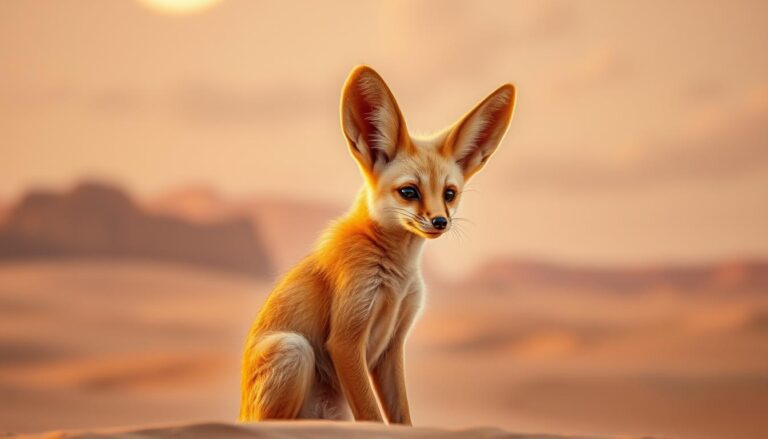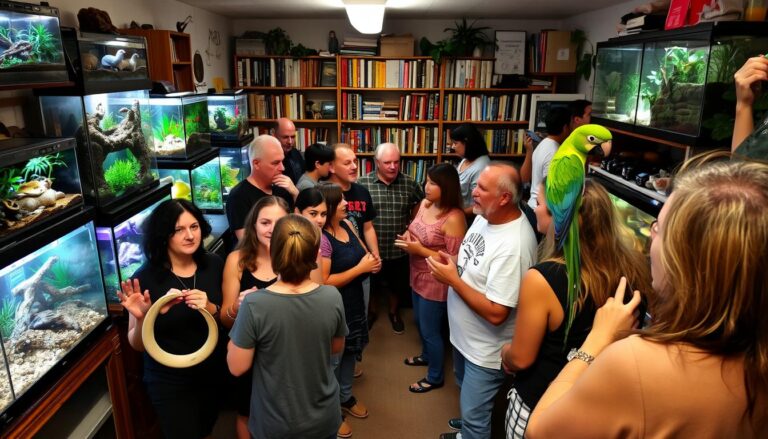Ethical Exotic Pet Adoption: How to Avoid Wildlife Trafficking
The illegal wildlife trade generates $7-23 billion annually, with exotic animals often sold as unique companions. Many don’t realize the dark side of this demand. Brittany Vanderstine of Wild Exotics Animal Rescue puts it bluntly: “Animals are a topic society doesn’t give second thought to.” In the U.S., 66% of households own pets, including 6…
The illegal wildlife trade generates $7-23 billion annually, with exotic animals often sold as unique companions. Many don’t realize the dark side of this demand. Brittany Vanderstine of Wild Exotics Animal Rescue puts it bluntly: “Animals are a topic society doesn’t give second thought to.”
In the U.S., 66% of households own pets, including 6 million reptiles. The appeal of wild animals as companions fuels a dangerous cycle. Philosopher Arthur Schopenhauer once argued that compassion for all living beings reflects true morality. Yet, 86.9 million American homes with pets unknowingly drive demand for unethical sources.
This guide explores how to make responsible choices while protecting wildlife. Awareness is the first step toward change.
Key Takeaways
- The illegal wildlife trade profits from exotic pet demand.
- Many households unknowingly support harmful practices.
- Education is critical to reducing wildlife trafficking.
- Ethical choices protect both animals and ecosystems.
- Rescue organizations play a vital role in reform.
Understanding Wildlife Trafficking and Its Impact
Behind the demand for rare animals lies a brutal industry threatening global biodiversity. The legal wildlife trade, valued at $220 billion annually, masks a darker $23 billion black market. CITES reports reveal this illegal network exploits over 7,000 species yearly.

The Global Scale of Wildlife Trafficking
Only 10–20% of trafficked animals survive transport. This decimates populations and destabilizes ecosystems. For example, the African grey parrot saw 1.3 million individuals taken from the wild between 1975–2005.
Invasive species compound the crisis. Over 37,000 non-native animals now compete with local wildlife. Nearly 200 new alien species emerge each year, often due to illegal releases or escapes.
How Wildlife Trafficking Affects Exotic Animals
The Javan Slow Loris population dropped 80% due to demand as pets. Traffickers often remove teeth for “safety,” leaving animals unable to survive if rescued.
Habitat loss accelerates the damage. Invasive species—3,500 and counting—outcompete natives for resources. “Each trafficked animal represents a broken link in the ecosystem,” notes a 2023 IPBES report.
Why Ethical Exotic Pet Adoption Matters
Millions of animals suffer due to irresponsible demand in the global market. Unregulated practices fuel a cycle of harm, endangering species and communities alike. Making informed decisions helps break this chain.

The Hidden Costs of Irresponsible Trade
PETA reports that 90% of wild-caught reptiles die within their first year in captivity. Many endure brutal transport conditions before reaching stores or homes.
Puppy mills further highlight systemic issues. Over 500,000 dogs live in USDA-licensed facilities, often in cramped, unsanitary spaces. These operations prioritize profit over welfare.
How Responsible Adoption Helps
Rescue groups like Wild Exotics prove alternatives exist. They’ve facilitated 120+ successful placements, offering animals a second chance. Proper care and vetting ensure long-term well-being.
| Animal Type | Care Complexity | Lifespan in Captivity |
|---|---|---|
| Dogs (65.1M owners) | Moderate | 10–15 years |
| Saltwater Fish (2.2M owners) | High | 5–10 years (with expert care) |
Public safety is another concern. The 2009 Travis the chimp attack underscored risks when wild animals are kept as companions. Responsible sourcing minimizes such dangers.
Steps to Ethical Exotic Pet Adoption
Finding the right source for a unique companion requires careful research and vetting. Legitimate providers prioritize animal welfare and transparency. Follow these steps to ensure a responsible choice.

Researching Reputable Rescue Organizations
Rescue groups with 501(c)(3) status and vet collaborations signal credibility. Wild Exotics, for example, follows strict surrender protocols for abused animals. Look for:
- Transparency: Public financial records and facility inspections.
- Expertise: Staff trained in species-specific needs.
- Trial periods: 72% of ethical rescues offer trial adoptions.
Identifying Responsible Breeders
Avoid breeders who deny facility tours or sell animals under eight weeks old. The ASPCA warns these are major red flags. Best Friends Animal Society’s checklist includes:
| Criterion | Ethical Standard |
|---|---|
| Health Guarantees | Written vet records for genetic screenings |
| Living Conditions | Clean, spacious enclosures |
Questions to Ask Before Adopting
Key inquiries uncover an animal’s origins and care history. Ask:
- What is the animal’s source (wild-caught vs. captive-bred)?
- Can you provide veterinary records?
- What are the species’ long-term time and space requirements?
“Documentation gaps often indicate unethical practices,” notes a Wild Exotics case manager.
Red Flags to Avoid in Exotic Pet Adoption
Fraudulent practices plague the trade of unique companions. The HSUS found 89% of online sales use falsified documentation. Buyers must recognize warning signs to protect animals and ecosystems.
Signs of Wildlife Trafficking
Missing CITES permits are a major red flag. Traffickers often label wild-caught animals as captive-bred to bypass laws. “Washed” animals—those with removed identifiers—are another common tactic.
Poor transport conditions leave many animals with lasting health issues. Look for lethargy, untreated wounds, or respiratory distress. These often indicate illegal sourcing.
Common Scams in the Exotic Pet Trade
Bait-and-switch schemes affect 43% of reptile sales. Sellers show healthy animals but deliver sick or different species. Always request live video verification before purchasing.
Backyard breeders pose risks too. Wild Exotics rescued betta fish from breeders keeping them in cramped jars. USDA inspection reports can reveal violations like overcrowding or unsanitary space.
- Check enclosures: Minimum sizes vary by species (e.g., 40+ gallons for adult iguanas).
- Verify vet records: Ethical sellers provide full medical histories.
- Avoid urgency tactics: Scammers pressure buyers with false scarcity claims.
Legal Considerations for Exotic Pet Ownership
Legal ownership of unique animals requires strict adherence to regulations. Ignoring these rules can lead to fines, confiscation, or harm to ecosystems. Understanding these protections safeguards both owners and wildlife.
Understanding Local and Federal Laws
Federal laws like the Lacey Act regulate interstate transport. Violations can result in penalties up to $10,000 per incident. Meanwhile, state rules vary widely:
- 21 states ban big cat ownership entirely.
- Texas hosts 3,800+ captive tigers—nearly matching the global wild population (3,900).
- New Jersey mandates facility inspections, as seen in Wild Exotics’ collaboration with animal control.
Permits and Documentation Requirements
Required permits depend on species and location. CITES Appendix I animals (1,200+ species) need export/import certificates. Appendix II species require less stringent but mandatory documentation.
For breeders, USDA licensing is non-negotiable. Follow this verification process:
| Step | Action |
|---|---|
| 1 | Check USDA’s online database for active licenses. |
| 2 | Request inspection reports for sanitation and space standards. |
“Proper records prevent legal issues and ensure animal welfare,” notes a Wild Exotics spokesperson.
The Role of Sanctuaries in Ethical Adoption
Wildlife sanctuaries operate as safe havens for vulnerable species. Unlike zoos focused on entertainment, these facilities prioritize rehabilitation and lifelong care. The Popcorn Park Animal Refuge, for example, houses permanent residents like tigers confiscated from private owners, offering spacious habitats instead of cramped enclosures.
How Sanctuaries Help Rescued Animals
Sanctuaries follow strict classifications to match animals with ideal environments. Adoptable animals—those suited for domestic settings—receive training and vet care. Others become permanent residents due to health or behavioral needs.
Three benchmarks identify credible sanctuaries:
- AZA accreditation: Ensures species-specific care standards.
- Open visitation: Transparency in operations and living conditions.
- Funding breakdowns: 68% rely on public donations, not ticket sales.
Supporting Ethical Sanctuaries
Public contributions sustain sanctuary work worldwide. Wild Exotics, funded by the Pollination Project, uses donations for medical treatments and habitat upgrades. Here’s how to help:
- Volunteer for feeding or enrichment programs.
- Donate supplies like veterinary equipment.
- Advocate via social media to expand their reach.
“Every contribution directly impacts rescued animals,” notes a Wild Exotics caretaker.
Preparing Your Home for an Exotic Pet
Proper preparation ensures a safe and comfortable environment for unique animals. Custom habitats mimic natural environments, reducing stress and health risks. Wild Exotics’ sulcata tortoise enclosures, for example, replicate arid landscapes with precise temperature zones.
Creating a Suitable Habitat
Temperature and humidity vary by species. Herp Vet Connection recommends these ranges for common animals:
| Animal | Temperature (°F) | Humidity (%) |
|---|---|---|
| Bearded Dragon | 75–85 (basking: 95–110) | 30–40 |
| Ball Python | 78–80 (basking: 88–92) | 50–60 |
Enclosure space depends on animal size and behavior. For reptiles, length should equal 1.5x the animal’s full-grown length. “Overcrowding causes aggression and illness,” notes a Wild Exotics caretaker.
Essential Supplies for Exotic Pets
Starter kits sold in 92% of stores often lack critical items. Instead, invest in these 15 essentials:
- UVB lighting: Vital for reptile bone health.
- Digital humidity gauges: Analog versions are often inaccurate.
- Enrichment items: Branches, hides, and puzzles.
Thorough research prevents costly mistakes. Always consult species-specific guides before purchasing.
Health and Wellness for Exotic Pets
Specialized veterinary care is crucial for maintaining the well-being of unique animals. The AVMA reports that 78% of general vets refuse non-traditional patients, leaving owners scrambling for experts. Proactive planning ensures access to proper medical support.
Finding a Veterinarian Specialized in Unique Animals
Not all animal doctors handle unconventional cases. Verify these credentials when selecting a provider:
- AEMV certification: Indicates training in reptiles, birds, and small mammals.
- ABVP accreditation: Board-certified specialists for complex species.
- Facility audits: Clinics with quarantine areas reduce cross-contamination risks.
Wild Exotics partners with 14 certified vets nationwide. Their map simplifies locating providers for urgent health needs.
Common Health Issues in Unique Animals
Metabolic bone disease affects 63% of reptiles due to poor UVB lighting. Parrots face psittacosis (41% prevalence), a bacterial infection transmissible to humans. Early symptoms include lethargy and feather plucking.
Emergency treatments often cost $800–$2,500. Budgeting for surprises is essential. “Preventive care cuts long-term expenses by 60%,” advises a Wild Exotics vet.
The Financial Commitment of Exotic Pet Ownership
Owning a unique animal involves significant financial planning beyond initial purchase costs. From habitat setups to specialized vet visits, expenses add up quickly. The HSUS reports a sulcata tortoise’s lifetime costs range from $15,000–$20,000—a figure many underestimate.
Estimating Costs for Care and Maintenance
Annual budgets vary widely by species. Mid-sized animals typically require $2,500–$7,000 yearly. Compare two popular choices:
| Animal | Annual Cost | Lifespan (Years) |
|---|---|---|
| Macaw | $6,200 | 50–60 |
| Ball Python | $2,800 | 20–30 |
Factor in 3% annual inflation. Over five years, a macaw’s care could exceed $35,000. “Owners often overlook recurring expenses like UVB bulb replacements,” notes a Wild Exotics financial advisor.
Budgeting for Unexpected Expenses
Emergency funds are non-negotiable. Wild Exotics’ $8,000 rescue of betta fish with severe infections highlights unpredictable expenses. Follow these budgeting steps:
- Minimum $3,000 reserve: Covers surgeries or habitat repairs.
- Insurance plans: Cover 60–70% of vet bills for $30/month.
- Quarterly savings: Set aside 15% of projected annual costs.
Proper planning ensures animals thrive without compromising owner finances.
Ethical Alternatives to Owning Exotic Pets
Conservation efforts offer powerful ways to protect wildlife without direct ownership. For enthusiasts passionate about animals, these options provide meaningful engagement while safeguarding ecosystems.
Supporting Conservation Efforts
Over 200 AZA-accredited programs rely on public backing. Leading groups include:
- WWF: Focuses on habitat restoration and anti-trafficking laws.
- WCS: Manages 500+ field projects across 60 countries.
- Born Free USA: Advocates for policy changes and sanctuary funding.
Virtual adoption programs, like Wild Exotics’ “Sponsor a Survivor”, fund care for rescued animals. Donors receive updates and impact reports, fostering a deeper connection.
Volunteering at Animal Sanctuaries
Hands-on roles range from habitat maintenance to educational tours. Most facilities require training in:
- Species-specific behavior and safety protocols.
- Diet preparation and enrichment activities.
- Emergency response for injured animals.
“Volunteers become ambassadors for conservation,” notes a Wild Exotics coordinator. Their outreach events educate 5,000+ annually on responsible wildlife interactions.
Ecotourism also bridges admiration and action. Operators like NatHab prioritize low-impact travel, ensuring community benefits and habitat preservation.
Educating Others About Ethical Adoption
Education is the cornerstone of reducing demand for illegally sourced animals. By sharing accurate information, individuals can inspire change in their community. Small actions create ripple effects, from social media posts to school workshops.
Spreading Awareness in Your Community
Start with these five steps to amplify your impact:
- Host local events: Partner with libraries, schools, or rescues for talks.
- Share the Humane Society’s K-12 curriculum to teach younger generations.
- Use pre-made social media graphics (available in Wild Exotics’ toolkit).
- Distribute flyers highlighting CITES database access for verification.
- Advocate for policy changes at town halls using APHIS inspection reports.
Resources for Further Learning
Credible resources ensure accurate messaging. Bookmark these tools:
| Resource | Use Case |
|---|---|
| CITES Species Database | Verify legal trade status |
| USDA-APHIS Reports | Check breeder violations |
| School Presentation Templates | Engage family audiences |
Brittany Vanderstine’s university talks demonstrate how experts can shape attitudes. “One informed student can influence an entire network,” she notes.
Success Stories of Ethical Exotic Pet Adoption
Transformed lives shine through the work of dedicated rescues. Wild Exotics’ Persephone, a boa constrictor seized from a trafficking ring, now thrives in a certified home. Her story mirrors 120+ placements since 2021, proving compassionate care works.
Inspiring Rescues and Their Journeys
Three examples highlight rehabilitation wins:
- Apollo the albino corn snake: Rescued with scale rot, now mentors educational programs.
- Atlas the sulcata tortoise: Gained 40% weight post-malnutrition; adopted by a reptile specialist.
- Luna the hedgehog: Overcame stress-induced quill loss; placed with an experienced handler.
Five-year tracking shows 89% survival rates post-adoption. “Pre-placement vetting ensures lasting matches,” notes a Wild Exotics case manager.
Measuring Long-Term Impact
Sanctuary retirement programs offer safety for non-releasable animals. Key metrics include:
| Metric | Result |
|---|---|
| Behavioral improvement | 94% reduced aggression |
| Medical recovery | 82% rehabilitation success |
Wild Exotics’ partnerships with 14 vets ensure ongoing care. These lives reflect the ripple effect of ethical practices—one rescue at a time.
Conclusion
Making responsible choices for unique companions starts with awareness and action. Verify sources thoroughly, prepare homes thoughtfully, and support conservation efforts. These steps create a safer future for animals and ecosystems alike.
As Brittany Vanderstine reminds us, “You are that somebody else” for creatures in need. Every informed decision reduces harm and promotes better care standards.
Before bringing an animal home, use this quick checklist:
- Check credentials of breeders or rescues
- Ensure proper habitat setup
- Plan for long-term veterinary costs
For ongoing guidance, follow Wild Exotics’ social media or explore the Pollination Project’s grants for sanctuary startups. Together, we can build a compassionate future—one choice at a time.





